
Forts in India
Encyclopedia
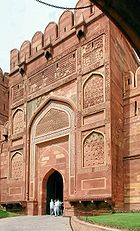
. The capital of each raja or chieftain was a fort around which a township grew and developed; this pattern can be seen in many South Asian cities such as Delhi
Delhi
Delhi , officially National Capital Territory of Delhi , is the largest metropolis by area and the second-largest by population in India, next to Mumbai. It is the eighth largest metropolis in the world by population with 16,753,265 inhabitants in the Territory at the 2011 Census...
, Agra
Agra
Agra a.k.a. Akbarabad is a city on the banks of the river Yamuna in the northern state of Uttar Pradesh, India, west of state capital, Lucknow and south from national capital New Delhi. With a population of 1,686,976 , it is one of the most populous cities in Uttar Pradesh and the 19th most...
, Lahore
Lahore
Lahore is the capital of the Pakistani province of Punjab and the second largest city in the country. With a rich and fabulous history dating back to over a thousand years ago, Lahore is no doubt Pakistan's cultural capital. One of the most densely populated cities in the world, Lahore remains a...
, Pune
Pune
Pune , is the eighth largest metropolis in India, the second largest in the state of Maharashtra after Mumbai, and the largest city in the Western Ghats. Once the centre of power of the Maratha Empire, it is situated 560 metres above sea level on the Deccan plateau at the confluence of the Mula ...
, Calcutta and Mumbai
Mumbai
Mumbai , formerly known as Bombay in English, is the capital of the Indian state of Maharashtra. It is the most populous city in India, and the fourth most populous city in the world, with a total metropolitan area population of approximately 20.5 million...
. Two forts in India are UNESCO world heritage sites the Agra fort
Agra Fort
Agra Fort, is a monument situated at Agra, is a UNESCO World Heritage site located in Agra, Uttar Pradesh, India. It is about 2.5 km northwest of its more famous sister monument, the Taj Mahal...
and the Red fort. The oldest surviving fort in India is the Qila Mubarak
Qila Mubarak
Qila Mubarak , is a historical monument in the heart of the city of Bathinda in India. It has been in existence from 90-110 AD in its current place. It was here that Razia Sultan, the first woman to take charge of the Delhi throne was incarcerated on her defeat and dethroned. The bricks of the...
at Bathinda which had it origins in 100 AD during the Kushan empire
Kushan Empire
The Kushan Empire originally formed in the early 1st century AD under Kujula Kadphises in the territories of ancient Bactria on either side of the middle course of the Oxus in what is now northern Afghanistan, Pakistan, and southern Tajikistan and Uzbekistan.During the 1st and early 2nd centuries...
, The Kangra Fort
Kangra Fort
The Kangra Fort , , is located 20 kilometers from the town of Dharamsala on the outskirts of the town of Kangra, India. The fort was first mentioned in Alexander the Great's war records, referring to the 4th century BC.-History:...
in Kangra believed to have been built by the still surviving Katoch
Katoch
Katoch is the name of a Rajput clan belonging to the Chandervanshi kshatriya lineage. Their traditional areas of residence was Trigarta Kingdom, Jalandhar, Multan i.e...
dynasty after the battle of Mahabharta. The fort was written about by the scribes of Alexander the Great, thus making it the oldest fort in Soham's India .
Medieval Delhi
Delhi
Delhi , officially National Capital Territory of Delhi , is the largest metropolis by area and the second-largest by population in India, next to Mumbai. It is the eighth largest metropolis in the world by population with 16,753,265 inhabitants in the Territory at the 2011 Census...
developed around Chandni Chowk, the township adjoining the Red Fort while and Kolkata
Kolkata
Kolkata , formerly known as Calcutta, is the capital of the Indian state of West Bengal. Located on the east bank of the Hooghly River, it was the commercial capital of East India...
came about around Fort William
Fort William, India
Fort William is a fort built in Calcutta on the Eastern banks of the River Hooghly, the major distributary of the River Ganges, during the early years of the Bengal Presidency of British India. It was named after King William III of England...
built by the British. Many small towns ranging from Jhansi
Jhansi
Jhansi Hindi:झाँसी, , Marathi: झाशी, is a historical city of India. Jhansi is the administrative headquarters of Jhansi District and Jhansi Division. The original walled city grew up around its stone fort, which crowns a neighboring rock. This district is on the bank of river Betwa.The National...
to Chandragiri
Chandragiri fort
Chandragiri Fort built in the 17th [century] is in Kasargod District of Kerala, south India.This large squarish fort is above sea level and occupies an area of about seven acres by the side of the river Payaswini...
grew around forts. Some towns even acquired the names from the forts. Durg
Durg
Durg is a city located in Chhattisgarh state, Central India. It is located just east of the Seonath River and is part of the Durg-Bhilai urban agglomeration. The city is an agricultural market and is heavily engaged in milling rice and pigeon peas. Durg gained importance as an industrial centre...
is fort in Hindi. Satara
Satara
Satara is a city located in the Satara District of Maharashtra state of India. The town is 2320 ft. above sea-level, near the confluence of the Krishna and its tributary river Venna. The city was the capital of the Maratha empire in the 17th century, hence one of the the historical cities of...
was so named because of the seventeen walls of the fort. Then there are famous monuments in certain cities and towns that overshadow the importance of the forts. Agra Fort
Agra Fort
Agra Fort, is a monument situated at Agra, is a UNESCO World Heritage site located in Agra, Uttar Pradesh, India. It is about 2.5 km northwest of its more famous sister monument, the Taj Mahal...
pales into comparative insignificance against the glory of the Taj Mahal
Taj Mahal
The Taj Mahal is a white Marble mausoleum located in Agra, India. It was built by Mughal emperor Shah Jahan in memory of his third wife, Mumtaz Mahal...
. Khajuraho
Khajuraho
The Khajuraho Group of Monuments in Khajuraho , a town in the Indian state of Madhya Pradesh, located in Chhatarpur District, about southeast of New Delhi, are one of the most popular tourist destinations in India. Khajuraho has the largest group of medieval Hindu and Jain temples, famous for...
temples overshadow Rajgarh Fort.
The conquest of, or battles for the forts of India have been significant occasions in Indian history. The capture of Qila Mubarak (Bathinda) in 1004 AD by Mahmud of Ghazni
Mahmud of Ghazni
Mahmud of Ghazni , actually ', was the most prominent ruler of the Ghaznavid dynasty who ruled from 997 until his death in 1030 in the eastern Iranian lands. Mahmud turned the former provincial city of Ghazni into the wealthy capital of an extensive empire which covered most of today's Iran,...
heralded the advent of Islamic rule in India
India
India , officially the Republic of India , is a country in South Asia. It is the seventh-largest country by geographical area, the second-most populous country with over 1.2 billion people, and the most populous democracy in the world...
. The struggle of Shivaji against the Mughals in the seventeenth century and his reign occur against the backdrop of forts in the Deccan. The capture of Seringapatam and death of Tippu Sultan in 1799 cemented British rule in South India. The capture of Gawilghur
Gawilghur
Gawilghur was a well-fortified mountain stronghold of the Maratha Empire north of the Deccan Plateau, in the vicinity of Melghat Tiger Reserve, Amravati District, Maharashtra. It was successfully assaulted by an Anglo-Indian force commanded by Arthur Wellesley on the 15 December 1803 during the...
by Arthur Wellesley
Arthur Wellesley, 1st Duke of Wellington
Field Marshal Arthur Wellesley, 1st Duke of Wellington, KG, GCB, GCH, PC, FRS , was an Irish-born British soldier and statesman, and one of the leading military and political figures of the 19th century...
, later Duke of Wellington, ended the Maratha
Maratha
The Maratha are an Indian caste, predominantly in the state of Maharashtra. The term Marāthā has three related usages: within the Marathi speaking region it describes the dominant Maratha caste; outside Maharashtra it can refer to the entire regional population of Marathi-speaking people;...
threat to British rule in Central India at the time of the Second Anglo-Maratha War
Second Anglo-Maratha War
The Second Anglo-Maratha War was the second conflict between the British East India Company and the Maratha Empire in India.-Background:...
.
The flag of independent India
Independence Day (India)
The Independence Day of India is celebrated on the fifteenth of August to commemorate its independence from British rule and its birth as a sovereign nation in 1947. The day is a national holiday in India. All over the country, flag-hoisting ceremonies are conducted by the local administration in...
was first unfurled from the ramparts of the Red Fort by none other than Jawahar Lal Nehru, first Prime Minister of India
Prime Minister of India
The Prime Minister of India , as addressed to in the Constitution of India — Prime Minister for the Union, is the chief of government, head of the Council of Ministers and the leader of the majority party in parliament...
on the morning of 15 August 1947. This practice of unfurling of flag followed by a speech by the Prime Minister continues each year on Independence Day. Just after World War II
World War II
World War II, or the Second World War , was a global conflict lasting from 1939 to 1945, involving most of the world's nations—including all of the great powers—eventually forming two opposing military alliances: the Allies and the Axis...
, the Red Fort had been the scene of the famous trial
INA trials
The INA trials or the Red Fort Trials refer to the courts martial of a number of officers of the Indian National Army between November 1945 and May 1946 variously for treason, torture, murder and abetment to murder....
of the Indian National Army
Indian National Army
The Indian National Army or Azad Hind Fauj was an armed force formed by Indian nationalists in 1942 in Southeast Asia during World War II. The aim of the army was to overthrow the British Raj in colonial India, with Japanese assistance...
.
Etymology
Most of the forts in India are actually castleCastle
A castle is a type of fortified structure built in Europe and the Middle East during the Middle Ages by European nobility. Scholars debate the scope of the word castle, but usually consider it to be the private fortified residence of a lord or noble...
s or fortresses. But when the British Government in India were cataloging them in the 17th–19th century they used the word forts as it was common in Britain then. All fortifications whether European or Indian were termed forts. Thereafter this became the common usage in India. In local languages the fort names are suffixed by local word for fort thus usage of the Sanskrit word durga, or Hindi word qila or the word garh or gad in Rajasthan, Assam and Maharashtra is common. For example, Suvarnadurg
Suvarnadurg
Suvarnadurg is a fort that is located on a small island in the Arabian Sea, near Harnai in Konkan, along the West Coast of India, in the Indian state of Maharashtra...
, Mehrangarh, Sudhagad
Sudhagad
Sudhagad is a hill fort situated in Maharashtra, India. It lies about west of Pune, south of Lonavla and east of Pali in Raigad District. The summit is above sea level.- History :...
etc.
Forts in ancient India
Three major methods were used for the construction of ancient Indian forts. The first consisted of earthen ramparts. Often they were constructed of the sand which was dug out of the ditch surrounding the fort. The second of rubble with earth on the outside which was more sturdy. The third type of construction was with stone and masonry work. The last was the strongest. Often materials from demolished forts were reused in the building of new forts.
By 4 BCE, fortified cities were common in India. The largest ones were between the city of Mathura (on the Yamuna river) and Magadha
Magadha
Magadha formed one of the sixteen Mahājanapadas or kingdoms in ancient India. The core of the kingdom was the area of Bihar south of the Ganga; its first capital was Rajagriha then Pataliputra...
(on the Ganges). Another series of forts in the south, was on the Ujjain
Ujjain
Ujjain , is an ancient city of Malwa region in central India, on the eastern bank of the Kshipra River , today part of the state of Madhya Pradesh. It is the administrative centre of Ujjain District and Ujjain Division.In ancient times the city was called Ujjayini...
(on the Narmada)leading into the Deccan. These are inferred by the remains of fort walls and bastions seen on excavation at Rajagriha and at several sites in the Gangetic plain notably Kaushambi. At the latter site huge walls of burnt brick, which look like they have been battered. There does not seem to be any formal planning of these forts.
There are few descriptions of these ancient structures. The most noted is the one by Megasthenes
Megasthenes
Megasthenes was a Greek ethnographer in the Hellenistic period, author of the work Indica.He was born in Asia Minor and became an ambassador of Seleucus I of Syria possibly to Chandragupta Maurya in Pataliputra, India. However the exact date of his embassy is uncertain...
, an ambasaddor of Seleucus I Nicator
Seleucus I Nicator
Seleucus I was a Macedonian officer of Alexander the Great and one of the Diadochi. In the Wars of the Diadochi that took place after Alexander's death, Seleucus established the Seleucid dynasty and the Seleucid Empire...
to the court of Chandragupta Maurya
Chandragupta Maurya
Chandragupta Maurya , was the founder of the Maurya Empire. Chandragupta succeeded in conquering most of the Indian subcontinent. Chandragupta is considered the first unifier of India and its first genuine emperor...
. He describes Patliputra
Patliputra
Pāṭaliputra , modern-day Patna, was a city in ancient India, originally built by Ajatashatru in 490 BC as a small fort near the River Ganges, and later the capital of the ancient Mahājanapadas kingdom of Magadha....
as being guarded by a ditch with wooden walls. The fort had 570 towers and 54 gates with colonnaded halls decorated with gold and silver. One such hall has been excavated and is one of the oldest stone structures in India.
Types of Ancient Indian Forts
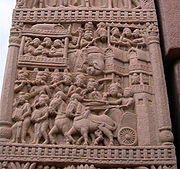
Arthashastra
The Arthashastra is an ancient Indian treatise on statecraft, economic policy and military strategy which identifies its author by the names Kautilya and , who are traditionally identified with The Arthashastra (IAST: Arthaśāstra) is an ancient Indian treatise on statecraft, economic policy and...
the Indian treatise on military strategy describes six major types of forts differentiated by their major mode of defense.
- Jal durg:a fortress surrounded by water, also known as audaka-durga and ab-durga. There are two subtypes - the island fortress, or antardvipa-durga, and the plain fortress or sthala-durga. The sea or the waters of a river wash the first like Murud-JanjiraMurud-JanjiraMurud-Janjira is the local name for a fort situated on an island just off the coastal village of Murud, in the Raigad district of Maharashtra, India...
.The latter is encircled with artificial moats filled with water or irrigated by a river. Plain fortresses are naturally much more common.
- Giri durgs: Giri-durga, or parvata-durga, is a hill or mountain fortress. There are three varieties: prantara-durga, giri-parshva-durga and guha-durga. Prantara-durga is a fortress built on the summit (usually flat) of a hill or a mountain. This was the most common type in the Middle Ages, and the best examples are the castles of Gwalior, Mehrangarh and Chittor . In giri-parshva-durga both major civilian structures and fortifications extend down the slope of a hill or mountain though the summit is certainly included into the defence system, too. The living quarters of a guha-durga fortress are situated in a valley surrounded by high, impassable hills. The hills house a chain of outposts and signal towers connected by extensive defensive walls.
- Vana durg or vrikshya-durga, would be surrounded on all sides with a dense, impassable forest over a distance of at least 4 kroshas(14.6 km). Variations were the khanjana-durga, built on fens and encircled with thorny woods, and the sthambha-durga, erected in the jungles among high trees but lacking sufficient sources of water.
- Dhanu durg Dhanvana, dhanva, or maru-durga are desert fortresses, usually to be found in an arid area bare of trees, grass or sources of water over a distance of no less than 5 yojanas (73 km), hence its other name, nirudaka-durga, or waterless fortress. An airina-durga is built on saline soil of barren tract or on fens impregnated with saline water and protected by the thorny bushes that grow there.
- Mahi durg There are three types of mahi-durga or earth fortress. Mrid-durga are encircled with earthen walls; the approaches to panka-durga are protected by fens or quicksand; and parigha-durga are surrounded by walls made of earth and stone or brick, their height exceeding 5.4m and their width constituting half of the height.
- Nar durg or fortress with men, was defended by a large and loyal army of proven warriors, and was well supplied with arms. It was usually a city fortress, well populated with a substantial garrison. It was also called nara-durga and bala-durga.
Each type of fortress had different advantages.Manu
Manu (Hinduism)
In various Hindu traditions, Manu is a title accorded to the progenitor of mankind, and also the very first brahman king to rule this earth, who saved mankind from the universal flood. He was absolutely honest which was why he was initially known as "Satyavrata"...
(author of the Manusmṛti a Vedic text) considered the hill forts offers the best defenses. Some Sanskrit text also consider hill forts to be the abode of gods and hence auspicious. Manu also considers the disadvantages of other fortresses. A fortress surrounded by water often sheltered reptiles and snakes, which made for a rapid spread of disease; on the other hand, reptiles and snakes could deter an assault on a fortress, and disease could force the enemy to lift a siege.Earth fortresses often swarmed with rats and rodents, which might in the long run eat away their foundations. Monkeys plagued the inhabitants of arboreal fortresses, while a fortress that housed a lot of people had to be kept well supplied with food and water to feed all those mouths.However the Mahabharata
Mahabharata
The Mahabharata is one of the two major Sanskrit epics of ancient India and Nepal, the other being the Ramayana. The epic is part of itihasa....
considers Nri-durga to be the best defensive structures. Most of the time a combination of defenses were used to guard the fort.Ranthambhore Castle, for example, stands on a hill (giri-durga) and used to be surrounded by dense forests (vana-durga). When a considerable garrison of soldiers was billeted in it, the castle could also be classified as nri-durga.
The method of planning of the fort is also described along with the layout of the roads. Kautilya suggests that the roads should be laid along the four cardinal directions with a temple at the centre. The Kings house should be at the north.
One of the oldest and most well preserved of such structures are the excavated ruins of ancient fortifications at Sisupalgarh
Sisupalgarh
Sisupalgarh or Sishupalgarh are a ruined fortification in Khurda District in Orissa, India. It is the largest and best preserved early historic fortification in India.-Description:...
in Orissa
Orissa
Orissa , officially Odisha since Nov 2011, is a state of India, located on the east coast of India, by the Bay of Bengal. It is the modern name of the ancient nation of Kalinga, which was invaded by the Maurya Emperor Ashoka in 261 BC. The modern state of Orissa was established on 1 April...
. It is estimated to date from the 3rd century BCE and was in occupation for a thousand years at least. Outlines of the fort indicate it had eight gates and thick walls. The western gate was quite elaborate. In 2005, sonar analyais suggested the presence of a deep moat around the fort.
Forts in Medieval India
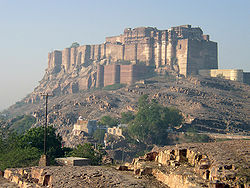
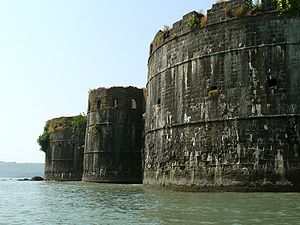
The construction of a citadel in the centre and putting in more area between the citadel and the walls was characteristic of Muslim forts (influenced in turn by the Norman motte and bailey). Classic examples of such structures are the Golkonda and the Berar fort.
The gates of medieval Indian forts were highly decorated. Two distinct styles are seen. The Hindu style with a lintel and the Mughal style with an arch. Gates in Indian forts were often high and wide to allow elephants to pass. Often they had rows of sharp, stout iron spikes to dissuade the breaking down of the gate by the elephants of an invading army. Such a gate with spikes can be seen on the Shaniwarwada fort, Pune. The walls of the forts were often looked higher from the outside than the inside as the forts made use of the natural rock formations on hills. This not only gave an illustion of greater height but also lead to the lower walls of the fort to be entirely made up of natural rock providing almost a perfect defense against the use of a battering ram or elephants to tear down the walls.
Construction
Stone was the main material for building fortifications in medieval India. Walls were erected by one of the following three construction methods. A wall could be an earthen rampart faced with stone on both sides. The rampart was built using the earth excavated while digging the ditch, with three-quarters of it usedfor building a rampart and one-quarter for levelling out the surface inside the fortress and in front of the ditch. Facing the rampart with stone allowed for the erection of higher and steeper walls than those possible with a purely earthen rampart. The structure had a substantial shortcoming, however: an earthen core accumulated water, which could destroy the stone shell. Drainage channels were therefore installed along the length of the wall from top to bottom.
The second method consisted of filling the space between the outer layers with earth mixed with rubble. This core was considerably harder than simply using rammed earth. The third and most advanced method involved the use of
mortar. A rubble-built wall fastened with mortar was strong and long lasting. Construction methods depended, however, on the materials available.
In medieval India, several reports exist of the practice of burying humans either dead or alive in the foundations of fort walls, to ensure their stability, being widely followed. It was believed that the ghosts of those sacrificed as such would keep evil spirits away. During the building of the Sri Qila, Delhi Alauddin Khilji
Alauddin Khilji
Ali Gurshap Khan better known by his titular name as Sultan Ala-ud-din Khilji was the second ruler of the Turko-Afghan Khilji dynasty in India.He was a well and capable ruler. He belonged to the Afghanized Turkic tribe of the Khiljis...
is reported to have buried 8,000 skulls of Mughals killed by him into the foundation. During the building of Purandar Fort
Purandar fort
Purandar fort पुरंदर किल्ला figures repeatedly in the rising of Shivaji against the Bijapur kingdom and the Mughals. Purandhar fort stands 4,472 ft. above the sea in the Western Ghats, 20 miles southeast of Pune. It actually consists of two forts - Purandar and Vajragad...
one its bastions gave way several times. The king of Berar
Berar Sultanate
-Berar in Ancient History:Subah Berar and Gondwana the Vidarbha region known as Gulshan-e-Berar in medieval period since Khilji dynasty to mughal period according Aine-Akbari and Alimgeer Namah report the berar is hole Fourteen sarkar...
then ordered his minister a Esaji Naik Chive to bury a first born son and his wife into the foundation of the bastion. This was promptly done and after a further offering of gold and bricks. When the bastion was finished Esaji Naik was given possession of the fort and the father of the sacrificed boy was rewarded with two villages. This custom was also followed by Shivaji when he built his forts.
Many Indian fortifications have parapets with peculiarly shaped merlon
Merlon
In architecture, a merlon forms the solid part of an embattled parapet, sometimes pierced by embrasures. The space between two merlons is usually called a crenel, although those later designed and used for cannons were called embrasures.-Etymology:...
s and complicated systems of loopholes,
which differ substantially from similar structures in other countries. Typical Indian merlons were semicircular and
pointed at the top, although they were sometimes fake: the parapet may be solid and the merlons shown in relief
on the outside (as at Chittorgarh). What was unique is the arrangement and direction of loopholes. Loopholes
were made both in the merlons themselves, and under the crenels. They could either look forward (to command
distant approaches) or downward (to command the foot of the wall). Sometimes a merion was pierced with two
or three loopholes, but more often, one loophole was divided into two or three slits by horizontal or vertical
partitions.The shape of loopholes, as well as the shape of merlons, need not have been the same everywhere in
the castle, as shown by Kumbhalgarh.
Forts constructed by the British
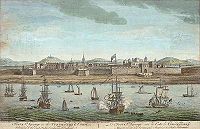
Fort William, India
Fort William is a fort built in Calcutta on the Eastern banks of the River Hooghly, the major distributary of the River Ganges, during the early years of the Bengal Presidency of British India. It was named after King William III of England...
in Kolkata
Kolkata
Kolkata , formerly known as Calcutta, is the capital of the Indian state of West Bengal. Located on the east bank of the Hooghly River, it was the commercial capital of East India...
, Fort St George
Fort St George
Fort St George is the name of the first English fortress in India, founded in 1639 at the coastal city of Madras, the modern city of Chennai. The construction of the Fort provided the impetus for further settlements and trading activity, in what was originally a no man's land...
in Chennai
Chennai
Chennai , formerly known as Madras or Madarasapatinam , is the capital city of the Indian state of Tamil Nadu, located on the Coromandel Coast off the Bay of Bengal. Chennai is the fourth most populous metropolitan area and the sixth most populous city in India...
were the main bastions constructed. These cities developed from the small townships outside the forts. Parsimony of the East India Company, non-availability of trained engineers and use of local materials and artisans resulted in the simple design and construction initially. The vulnerability of these earlier forts, hostilities with the French and the growing might of the Company resulted in stronger and more complex designs for the second round of construction, the design of Fort St George reflecting the influences of the French engineer Vauban
Vauban
Sébastien Le Prestre, Seigneur de Vauban and later Marquis de Vauban , commonly referred to as Vauban, was a Marshal of France and the foremost military engineer of his age, famed for his skill in both designing fortifications and breaking through them...
.

